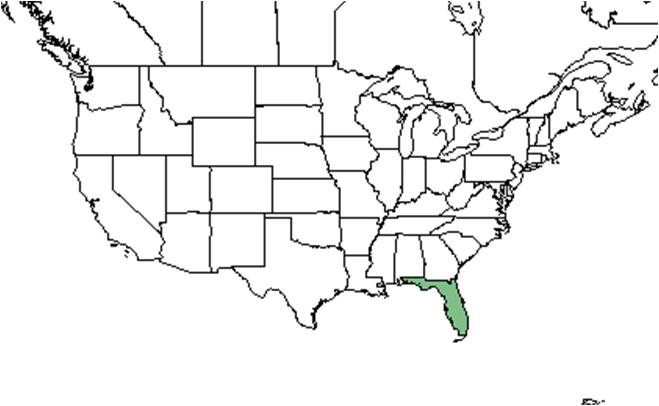Paronychia chartacea
| Paronychia chartacea | |
|---|---|

| |
| Photo by Shirley Denton (copyrighted, use by photographer’s permission only), Atlas of Florida Vascular Plants | |
| Scientific classification | |
| Kingdom: | Plantae |
| Division: | Magnoliophyta - Flowering plants |
| Class: | Magnoliopsida – Dicotyledons |
| Order: | Caryophyllales |
| Family: | Caryophyllaceae |
| Genus: | Paronychia |
| Species: | P. chartacea |
| Binomial name | |
| Paronychia chartacea Fernald | |

| |
| Natural range of Paronychia chartacea from USDA NRCS Plants Database. | |
Common name: paper nailwort
Contents
Taxonomic notes
Synonyms: Paronychia chartacea Fernald var. minima (L.C. Anderson) R.L. Hartman; Nyachia pulvinata Small; P. chartacea Fernald ssp. minima L.C. Anderson
Description
A description of Paronychia chartacea is provided in The Flora of North America.
Distribution
There are two isolated subspecies. P. chartacea ssp. chartacea can be found in scrub habitats of the Florida peninsula, this subspecies is a short-lived perennial. P. chartacea ssp. minima is found in the karst region of the northwest Florida panhandle, it has been described as somewhat less pubescent than P. chartacea ssp. chartacea, and is annual [1][2]. Much of the distinction between the two subspecies is minimal. [3]
Ecology
Habitat
FSU Herbarium specimen have documented P. chartacea in sand pine scrubs with Hypericum cumulicola, herbarium labels do not specify what subspecies these specimen are. It can be inferred that the individuals growing in this habitat are of P. chartacea ssp. chartacea based on previous knowledge of the distribution of the two subspecies. P. chartacea ssp. chartacea is restricted to the Lake Wales Ridge in Highlands, Polk, Osceola, Orange and Lake Counties. Within this range, it is found growing in sand pine scrubs and Florida rosemary scrubs[2]. Soils of this area include those of St. Lucie and Archbold soil types. [4] It is a gap specialist, occurring at greater densities in areas of open bare sand, and is one of the most abundant species in the rosemary scrub seedbank. [5]
P. chartacea ssp. minima is found in nearly pure stands in the karst region of the Florida panhandle (Washington and Bay counties). It has been observed growing with Amphicarpum muhlenbergianum, Bulbostylis barbata, B. ciliatifolia, Chrysopsis lanuginosa, Eriocaulon lineare and Hypericum lissophloeus [2].
Phenology
Flowers August through November and fruits in October. [6]
Seed bank and germination
Germination of P. chartacea ssp. chartacea is highest in intact scrubs because invertebrate predators may use the low shrub cover of the rosemary scrubs to hide from carnivorous predators which are less likely to forage in degraded scrubs. [7] Schafer et al. 2010 found it to be one of the most abundant species in the rosemary scrub seedbank. It is an annual and obligate seeder with germination frequency increasing post-burn. [8] Seedlings have been observed to germinate over a broad range of months. Cite error: Closing </ref> missing for <ref> tag
Halictidae: Lasioglossum miniatulus, L. nymphalis, L. placidensis
Pompilidae: Anoplius semirufus, Episyron conterminus posterus
Sphecidae: Tachysphex apicalis, T. similis
Vespidae: Leptochilus krombeini, Parancistrocerus salcularis rufulus
Conservation and management
P. chartacea ssp. chartacea is limited to the Lake Wales Ridge, which is threatened due to fragmentation from urban and agricultural development. The loss of the scrub habitat is the primary reason this subspecies is threatened[2]. By 1980, more than two-thirds of the historic scrub habitat was destroyed. [9] Fire suppression is also threatening to this species.
Cultivation and restoration
Photo Gallery
References and notes
Molly, E. H. and E. S. Menges (2002). "Allelopathic Effects and Root Distribution of Ceratiola ericoides (Empetraceae) on Seven Rosemary Scrub Species." American Journal of Botany 89(7): 1113-1118.
- ↑ [[1]] Center for Plant Conservation. Accessed: February 17, 2016
- ↑ 2.0 2.1 2.2 2.3 [[2]] FWS. Accessed: February 16, 2016
- ↑ Anderson, L. 1991. Paronychia chartacea ssp. minima (Caryophyllaceae): a new subspecies of a rare Florida endemic. Sida 14(3): 435-441.
- ↑ Abrahamson, W., A. Johnson, J. Layne, and P. Peroni. 1984. Vegetation of the Archbold Biological Station, Florida: An example of the Southern Lake Wales Ridge. Florida Scientist. 47(4):209-250.
- ↑ Schafer, J. L., E. S. Menges, et al. (2010). "Effects of Time-Since-Fire and Microhabitat on the Occurrence and Density of the Endemic Paronychia chartacea ssp. chartacea in Florida Scrub and Along Roadsides." The American Midland Naturalist 163(2): 294-310.
- ↑ Florida State University Robert K. Godfrey Herbarium database. URL: http://herbarium.bio.fsu.edu. Last accessed: October 2015. Collectors: Loran C. Anderson, Wilson Baker, L.J. Brass, Angus Gholson, Robert K. Godfrey, Ann Johnson, Beverly Judd, Walter Judd, Olga Lakela, Eric S. Menges, Susan Wallace, D.B. Ward. States and Counties: Florida: Bay, Highlands, Polk, Washington. Compiled by Tall Timbers Research Station and Land Conservancy.
- ↑ Stephens, E. L., L. U. Z. Castro-Morales, et al. (2012). "Post-Dispersal Seed Predation, Germination, and Seedling Survival of Five Rare Florida Scrub Species in Intact and Degraded Habitats." The American Midland Naturalist 167(2): 223-239
- ↑ Weekley, C. W. and E. S. Menges (2003). "Species and Vegetation Responses to Prescribed Fire in a Long-Unburned, Endemic-Rich Lake Wales Ridge Scrub." The Journal of the Torrey Botanical Society 130(4): 265-282.
- ↑ Christman, S. 1988. Endemism and Florida’s interior sand pine scrub. Final project report, project no. GFC-84-101. Florida Game and Fresh Water Fish Commission; Tallahassee, Florida